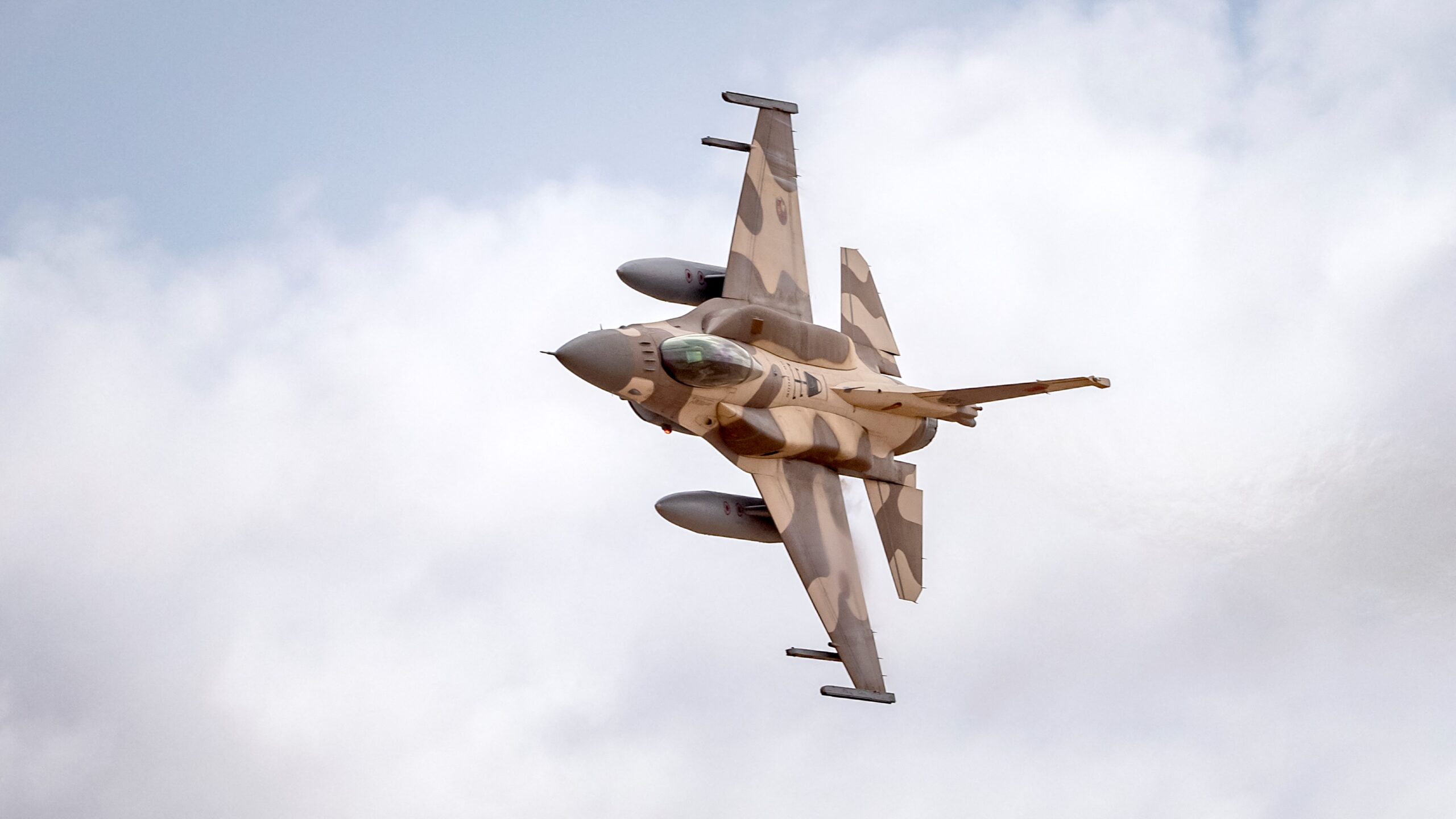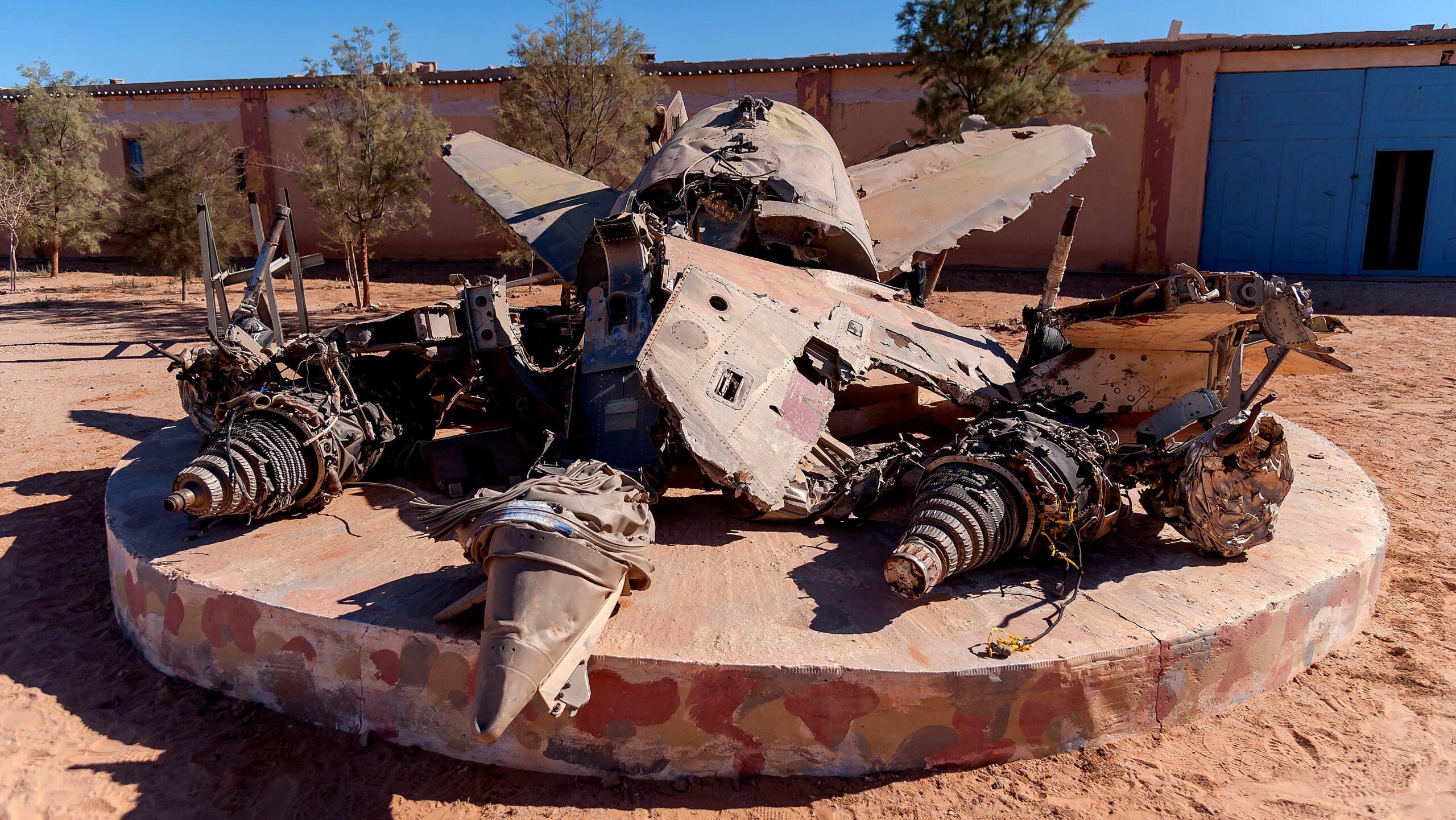
A Royal Moroccan Air Force F-16 Fighting Falcon fighter aircraft flies over during the second annual “African Lion” military exercise in the Tan-Tan region in southwestern Morocco on June 30, 2022. (FADEL SENNA/AFP via Getty Images)
BEIRUT: While it may not make the rounds in Washington as one of the big geopolitical rivalries of the era, tensions between Morocco and Algeria are real, and have escalated in recent years thanks to a dispute over the Western Sahara, which Morocco claims to be its own territory, while Algeria backs the Tindouf-based Polisario Front rebel group.
As a result, both nations have begun investing heavily in their militaries — and specifically in airborne systems that can counter one another.
Now, an aviation arms race may be escalated further by a need for Russia to find defense exports in the wake of its invasion of Ukraine, and subsequent sanctions pain. Algeria, a longstanding military client of Russia, could suddenly see cheaper rates for the Su-57, or even end up as the first export customer for the Su-75 Checkmate.
“At this point, as one of the biggest global customers of Russian weaponry, it’s likely that Algeria may eventually acquire Russia’s top-notch technology that Moscow seeks to export,” Samuel Bendett, a member of the Russia Studies Program at CNA and an adjunct senior fellow at the Center for a New American Security, told Breaking Defense. “This may include Su-57 down the line, but it’s also likely that Algeria may start importing Su-75 Checkmate fighter, once it goes into production, considering how much Moscow is seeking to export its new military technology.”
In turn, Morocco is looking to bolster its own advanced air assets, spending heavily on American-made jets and helicopters.
“It appears that both countries seek to bolster their military capabilities with new technologies, including air force. Given the regional geography where both countries are located — large territory, long distances — air force capabilities are crucial for monitoring, ISR and combat,” Bendett said.
Mounting Tensions In The Region
Tensions between the two countries have simmered for years, but intensified in December 2020 after Morocco normalized ties with Israel and the US recognized the kingdom’s sovereignty over the Western Sahara.
In August 2021, Algeria cut diplomatic relations with Morocco, after what it called “hostile actions by its most populous neighbor with which it has had strained relations for decades.” Algerian Foreign Minister Ramdane Lamamra accused Morocco of using Pegasus spyware against its officials, supporting a separatist group and failing in bilateral commitments, including on the Western Sahara issue.
In the last few months, the verbal attacks between the two countries have increased. In January, Morocco’s King Mohammed VI declared the creation of a new “eastern military zone” along its border with Algeria, a move described in media reports as “a statement of intent meant to indicate Morocco’s readiness to confront any military provocations from its eastern neighbor.” And just weeks ago, Algeria suspended a two-decade old cooperation treaty with Spain, after Madrid backed the position of Morocco on the disputed Western Sahara.
With such defense deals and interests, is there an actual potential for an armed conflict between the two countries?
“Earlier I would have asserted that there is no such possibility, but after the Russian invasion to Ukraine with all its geostrategic implications and the escalated Algerian speech towards Morocco, the possibilities are high for such a conflict,” Abdel Hamid Harfi, a Moroccan military expert, told Breaking Defense.
Harfi said large-scale war between the two countries is highly unlikely, both because of their limited economic resources and because they are located on the southern borders of Europe, meaning European counties will intervene to stop such a scenario.
“But the probability is high for border skirmishes between the two countries,” he warned.
Fifth-Generation Goals For Both Nations
According to an April 2022 report by the Stockholm International Peace Research Institute, both nations are spending significantly on defense.
The report stated that, while Algerian military spending decreased sharply compared to previous years, it stabilized in 2021 at 6.1%, where Algeria had a total of $9.1 billion in military. From its side Morocco had spending increased military spending by 3.4% with a total of $5.4 billion in 2021.
Those aren’t massive totals by US standard, but for comparison, 3.4% of GDP would top every NATO nation’s GDP spending on defense except Greece and the US; $5.4 billion is more than Denmark, the Czech Republic or Lithuania spent in 2021. Algeria’s total puts it 26th in the world in terms of defense spending, per SIPRI.
There is real money being spent, and it is being spent in both nations, primarily as a result of each other — with Moscow and Washington serving as the primary beneficiaries.

The remains of an Air Force Mirage F1 of the Royal Moroccan Air Force, downed from Sahrawi army in the Saharawi refugee camp Rabouni on January 3, 2019 in Tinduf, Algeria. (Stefano Montesi – Corbis/Corbis via Getty Images)
Russian-Algerian defense cooperation goes back to the Soviet Union, but has strengthened in recent decades.
“Early on, Russian President Vladimir Putin took a strategic long view of Russia’s weapons sale relationship with Algeria,” Michaël Tanchum, non-resident fellow at the Middle East Institute and a senior fellow at the Austrian Institute for European and Security Policy, told Breaking Defense. “In 2006, Putin cancelled Algeria’s $4.7 billion Soviet-era military debt in exchange for a promise to purchase $7.5 billion in new Russian weapons in the future. When Algeria’s oil and natural gas revenues rose, Algiers became Russia’s third largest customer.”
As a result, “Algeria’s arsenals are full of relatively proven, less expensive and tried Russian weapons,” Bendett said. Among them, a fleet of aging Su-30, MiG-29, Su-24 and MiG-25 fighter jets.
In recent years Algeria has shown frequent interest in procuring the Su-57, Sukhoi’s fifth generation Russian fighter, and Russian outlet Sputnik reported in November 2020, that Algeria bought 14 Su-57 fighters from Moscow worth $2 billion, with expected deliveries by 2025. (Russia confirmed in February 2021 that a first foreign request for SU-57 was received but didn’t state who the buyer was.)
The two countries announced in May 2022 that they are considering developing their military cooperation, with joint military exercises scheduled for next November in the Algerian desert. That makes Algeria one of a handful of countries to stand by Russia since its February invasion of Ukraine.
RELATED: Morocco moves to become maintenance hub for F-16s, C-130s
Morocco, for its part, has in recent years bought heavily from the US defense industry. Rabat went under contract for 25 F-16C/D Block 72 aircraft in February 2019, and the Royal Moroccan Air Force is expecting the delivery of the new aircraft to start 2025. Adding to this Morocco signed a contract with Boeing in June 2020, for 24 of its AH-64 Apache helicopters, with deliveries to commence by 2024.
Meanwhile, Morocco and the US are conducting the largest military drills in Africa, African Lion 2022, which for the first time in its 18 editions had four theaters of operations: Morocco, Tunisia, Ghana and Senegal.
Whether Morocco will pursue a fifth-generation jet is more unclear. There have been news reports that Rabat is interested, and the Israeli website JaFaj claimed in Jan. 2022 that during a visit by Israeli Minister of Defense Benny Gantz to Morocco, his Moroccan counterpart requested aid in obtaining F-35 from the US.
However, there has been no official request by Rabat to the US about the F-35, and Harfi believes any goal of getting the F-35 would have to be a long-term one.
“Morocco has no intention in the short and medium terms to buy F-35 for many reasons,” Harfi said. “First, Morocco has two large combat aircraft contracts for F-16 Block 72 and Apache helicopters to be received by 2025, so it doesn’t have the financial capabilities and the needed infrastructure for other large purchases. Also, the upgraded F-16 Block 70 and 72 have similar operational capabilities to the F-35, so the air force isn’t in dire need for the fifth-generation fighters.”
For his part, Bendett noted that high-end fighters can eat a defense budget up quickly.
Said Bendett, “This leads to questions whether such a race is in fact sustainable, given the rising prices of modern military technology and each country’s domestic politics, economics, and internal affairs.”
Other Suppliers For Both Nations
Of course, Russia and the US are not the only suppliers of weapons the two countries can look at as they expand their air arsenals. And there are reasons to think both Washington and Moscow may struggle to actually cash in on the tensions between Morocco and Algeria.
For Morocco, the infamously long approval times by the US for defense sales, and the associated political conditions Washington puts on its weapons, means they may look to other options.
“There is a wider trend among Arab states in the MENA region to seek strategically significant weapons systems when the US is less forthcoming. Besides Germany, France, and Italy, Turkey and Israel have emerged as key suppliers of cutting-edge weapons technology,” Tanchum said.
He added that in some circumstances, countries have turned to China to supply sensitive technologies because Beijing, unlike Turkey and Israel, is not constrained by its close security cooperation with the US.
For Algeria, Moscow is likely to remain happy to sell weapons with few strings attached — but Russia’s industry is struggling mightily and may not be able to actually deliver the goods. And unlike a country like Syria, for example, where Russia is the only real game in town, Algeria could have options.
Once again, China could become a greater plater in the region, Bendett predicted, noting it “may emerge as a significant supplier or arms across Middle East if either Russian or US weapons are not available for some reason — that is, Beijing may start supplying a greater share of weapons and systems beyond its combat drones that are already flying in the region.”
Algeria is currently showing interest in local serial production of the L-39NG trainer, produced by Czech Republic firm Aero Vodochody. The L-39 platform is originally the trainer for eastern fighters, and 30 L-39 trainers are still currently operational with the Algerian air force.
“Specific scope of work for industrial cooperation or serial production of L-39NG haven’t been discussed yet between AAF and AVA until now. However, with Algeria being such a prominent user of the L-39 platform in the past, we naturally do see a very big potential for the L-39NG. Should the interest and the volume be significant enough, Aero is experienced and will offer partial transfer of workshare to a local industrial entity. Everything depends on the customer’s requirements and the capability of local industry, which we believe to be high,” Filip Gunnar Kulštrunk, vice president of sales and marketing at Aero Vodochody, told Breaking Defense.






















